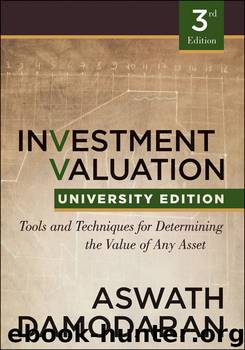Investment Valuation: Tools and Techniques for Determining the Value of any Asset, University Edition by Aswath Damodaran

Author:Aswath Damodaran
Language: eng
Format: epub
ISBN: 9781118206591
Publisher: Wiley
Published: 2012-03-01T16:00:00+00:00
With the sample size about 1,600 firms, this regression represents the broadest measure of relative value.
This regression has a low R-squared, but it is more a reflection of the noise in PE ratios than it is on the regression methodology. As you will see, the market regressions for price-to-book value and price-to-sales ratios tend to be better behaved and have a higher R-squared than PE ratio regressions. The other disquieting finding is that the coefficients on the variables do not always have the signs you would expect them to have. For instance, higher-risk stocks (higher betas) have higher PE ratios, when fundamentals would lead you to expect the opposite.
The coefficient on the expected growth rate in the regressions offers some useful insight into how the market is pricing growth differences across stocks. In the following table, we report this number each year from January 2000 to January 2011, in conjunction with the implied equity risk premiums that we computed in Chapter 7 (as a price of risk):
Time PE Value of Extra Equity Risk
Period 1% of Growth Premium
Jan-11 0.836 5.20%
Jan-10 0.550 4.36%
Jan-09 0.780 6.43%
Jan-08 1.427 4.37%
Jan-07 1.178 4.16%
Jan-06 1.131 4.07%
Jan-05 0.914 3.65%
Jan-04 0.812 3.69%
Jan-03 2.621 4.10%
Jan-02 1.003 3.62%
Jan-01 1.457 2.75%
Jan-00 2.105 2.05%
In January 2000, at the peak of the dot-com boom, the market was paying a very high price for growth, while charging very little for risk; not surprisingly, high-growth, high-risk firms traded at sky-high PE ratios. By January 2002, the wheel had turned, with the price for growth dropping by more than 50 percent and the price of risk increasing almost 80 percent. In January 2009, right after the banking crisis, the market price for risk was 6.43 percent (the highest level in 30 years), and the price paid for growth was low; the median PE ratio for U.S. firms was in single digits as a consequence.
Problems with the Regression Methodology
The regression methodology is a convenient way of compressing large amounts of data into one equation capturing the relationship between PE ratios and financial fundamentals. But it does have its limitations. First, the independent variables are correlated with each other.5 For example, high-growth firms tend to have high risk and low payout ratios, as is clear from Table 18.2, which summarizes the correlations between beta, growth, and payout ratios for all U.S. firms. Note the negative correlation between payout ratios and growth, and the positive correlation between beta and growth. This multicollinearity makes the coefficients of the regressions unreliable (increased standard error) and may explain the wrong signs on the coefficients (such as beta having a positive coefficient) and the large changes in these coefficients from period to period. Second, the regression is based on a linear relationship between PE ratios and the fundamentals, and that might not be appropriate. An analysis of the residuals from a regression may suggest transformations of the independent variables (squared or natural logs) that work better in explaining PE ratios. Third, the basic relationship between PE ratios and financial variables itself is not stable,
Download
This site does not store any files on its server. We only index and link to content provided by other sites. Please contact the content providers to delete copyright contents if any and email us, we'll remove relevant links or contents immediately.
| Private Equity | Valuation |
| Venture Capital |
The Black Swan by Nassim Nicholas Taleb(7010)
Bad Blood by John Carreyrou(6543)
Pioneering Portfolio Management by David F. Swensen(6226)
Millionaire: The Philanderer, Gambler, and Duelist Who Invented Modern Finance by Janet Gleeson(4374)
Skin in the Game by Nassim Nicholas Taleb(4161)
Bullshit Jobs by David Graeber(4094)
The Money Culture by Michael Lewis(4073)
Skin in the Game: Hidden Asymmetries in Daily Life by Nassim Nicholas Taleb(3929)
The Wisdom of Finance by Mihir Desai(3650)
Blockchain Basics by Daniel Drescher(3495)
Liar's Poker by Michael Lewis(3367)
Fooled by Randomness: The Hidden Role of Chance in Life and in the Markets by Nassim Nicholas Taleb(3043)
Hands-On Machine Learning for Algorithmic Trading by Stefan Jansen(3026)
The Intelligent Investor by Benjamin Graham Jason Zweig(2995)
Mastering Bitcoin: Programming the Open Blockchain by Andreas M. Antonopoulos(2980)
The Power of Broke by Daymond John(2896)
Investing For Dummies by Eric Tyson(2893)
Market Wizards by Jack D. Schwager(2643)
Zero Hour by Harry S. Dent Jr. & Andrew Pancholi(2614)
